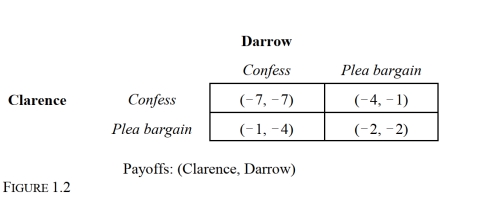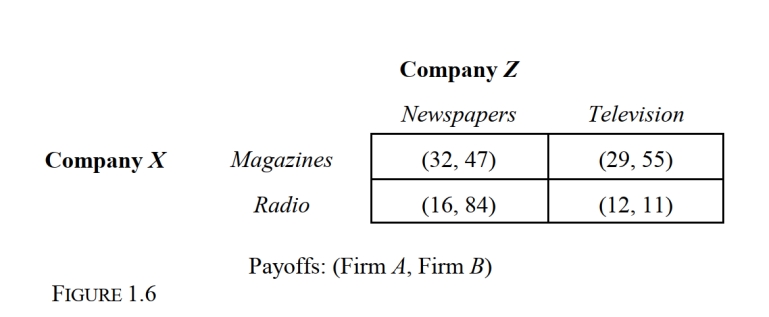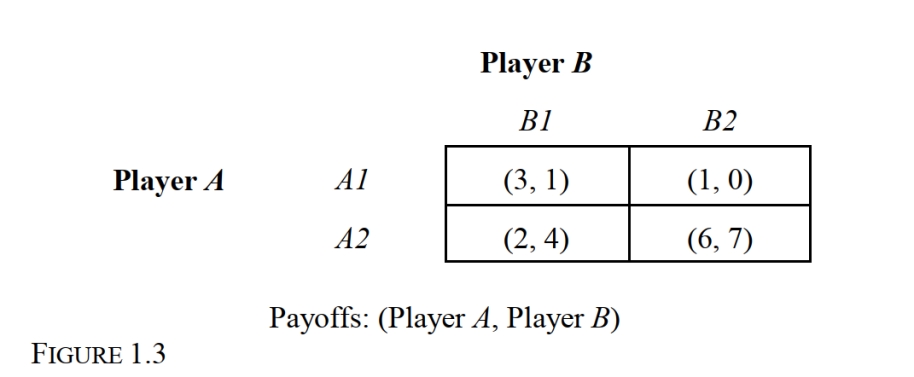A) Profit maximization.
B) Utility maximization.
C) The rationing function of markets.
D) Strategic behavior.
E) Capital budgeting.
Correct Answer

verified
Correct Answer
verified
Multiple Choice
A Nash equilibrium:
A) Results in a payoff that is no lower than any other payoff, regardless of the strategies adopted by the other players.
B) Results in the largest payoff for both players.
C) Occurs when each player adopts a strategy that he or she believes is the best response to the strategy adopted by a rival.
D) Results in the best of the worst possible payoffs.
E) Results in the lowest opportunity loss for all players.
Correct Answer

verified
Correct Answer
verified
Multiple Choice
A static game:
A) Is the same thing as a simultaneous-move game in that both players move without knowledge of the other player's move.
B) Is the same thing as a simultaneous-move game except that the players are unaware of the payoffs from alternative strategy profiles.
C) Is the same thing as a sequential-move game.
D) None of the above.
Correct Answer

verified
Correct Answer
verified
Multiple Choice
 -Consider the one-time, noncooperative, static game depicted in Figure 1.2. The Nash equilibrium strategy profile for this game is:
-Consider the one-time, noncooperative, static game depicted in Figure 1.2. The Nash equilibrium strategy profile for this game is:
A) {Confess, Confess}.
B) {Confess, Plea bargain}.
C) {Plea bargain, Confess}.
D) {Plea bargain, Plea bargain}.
E) This game does not have a Nash equilibrium strategy profile.
Correct Answer

verified
Correct Answer
verified
Multiple Choice
Strategic interaction:
A) Describes the situation in which the behavior of an individual or group affects, and is affected by, the behavior of other individuals or groups.
B) Is concerned with decision making involving move and countermove.
C) Is not important in games in which players have strictly dominant strategies.
D) Only a and b are correct.
E) All of the above.
Correct Answer

verified
Correct Answer
verified
Multiple Choice
The modern version of game theory can be traced to the groundbreaking work of:
A) Milton Bradley.
B) Rogers and Hammerstein.
C) Von Neumann and Morgenstern.
D) Arbuckle and Keaton.
E) Schilling and Harsanyi.
Correct Answer

verified
Correct Answer
verified
Multiple Choice
Simultaneous-move games are also called:
A) Noncooperative games.
B) Dynamic games.
C) Static games.
D) Normal-form games.
E) Bargaining strategies.
Correct Answer

verified
Correct Answer
verified
Multiple Choice
A collection of strategies is referred to as a:
A) Payoff matrix.
B) Nash equilibrium.
C) Focal-point equilibrium.
D) Normal-form game.
E) Strategy profile.
Correct Answer

verified
Correct Answer
verified
Multiple Choice
A two-player, static game is one in which the players move:
A) At different times, but without knowledge of the other player's move.
B) At the same time, but with prior knowledge of the other player's move.
C) Sequentially.
D) None of the above.
E) All of the above.
Correct Answer

verified
Correct Answer
verified
Multiple Choice
 -Consider the advertising game depicted in Figure 1.6 in which payoffs are in thousands of dollars. If larger payoffs are preferred, this is an example of a:
I. Game in which both players have a strictly dominant strategy.
II. Prisoner's dilemma.
III. Two-player, noncooperative, static game.
Which of the following is correct?
-Consider the advertising game depicted in Figure 1.6 in which payoffs are in thousands of dollars. If larger payoffs are preferred, this is an example of a:
I. Game in which both players have a strictly dominant strategy.
II. Prisoner's dilemma.
III. Two-player, noncooperative, static game.
Which of the following is correct?
A) I only.
B) II only.
C) III only.
D) II and III only.
E) I, II, and III.
Correct Answer

verified
Correct Answer
verified
Multiple Choice
The normal-form of a one-time, static game summarizes:
A) Players, alternative strategies, and payoffs.
B) Players, alternative strategies, and order of moves.
C) Alternative strategies, payoffs, and order of moves.
D) Players, order of moves, and payoffs.
E) Players, stages of the game, and payoffs.
Correct Answer

verified
Correct Answer
verified
Multiple Choice
Games in which the players alternate moves are called:
A) Static games.
B) Dynamic games.
C) Simultaneous-move games.
D) Multistage games.
E) Answers b and d are correct.
Correct Answer

verified
Correct Answer
verified
Multiple Choice
 -Refer to noncooperative, one-time, static game depicted in Figure 1.3. The Nash equilibrium strategy profile for this game is:
I. {A1, B1}.
II. {A1, B2}.
III. {A2, B1}.
IV. {A2, B2}.
Which of the following is correct?
-Refer to noncooperative, one-time, static game depicted in Figure 1.3. The Nash equilibrium strategy profile for this game is:
I. {A1, B1}.
II. {A1, B2}.
III. {A2, B1}.
IV. {A2, B2}.
Which of the following is correct?
A) I only.
B) II only.
C) III only.
D) I and III only.
E) II and IV only.
Correct Answer

verified
Correct Answer
verified
Multiple Choice
In a two-player, static game, players move:
A) At different times, but without knowledge of a rival's move.
B) At the same time, but with prior knowledge of a rival's move.
C) At same time, but without prior knowledge of a rival's move.
D) Answers a and c above.
E) None of the above.
Correct Answer

verified
Correct Answer
verified
Multiple Choice
Which of the following assumptions about static games with complete information is incorrect:
A) Players' strategies are common knowledge.
B) Payoffs from alternative strategy profiles are common knowledge.
C) Each player has a dominant strategy.
D) Players' identities are common knowledge.
E) Noncooperative static games are examples of the prisoner's dilemma.
Correct Answer

verified
Correct Answer
verified
Showing 21 - 35 of 35
Related Exams